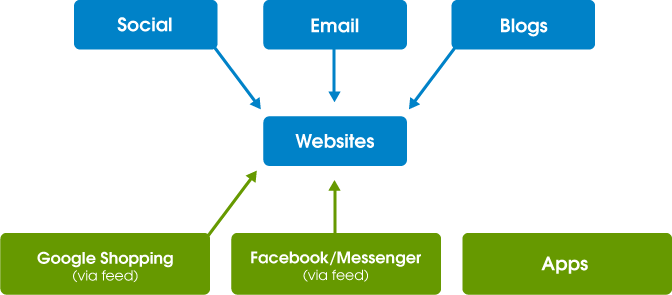The way many organisations plan their online presence today still looks something like this:

Interactions on all channels have the sole purpose of pointing prospects back to the company website, driving them through the funnel in just one location.
But if prospects are happy where they are, why are we so insistent on moving them? Why not communicate with consumers where and how they choose to, not how our technology ‘permits’ them?
You’ve probably started doing this without giving it much thought. For example you’ve probably added third party sites, such as Google Shopping and Facebook, into the mix over time.

Yet these platforms are increasingly becoming product destinations in their own right. It doesn’t take much imagination to add in Facebook and Google Pay and suddenly our customer will no longer bother even touching our websites.
And these platforms are multiplying. You just get to grips with three and then another three appear.
So how on earth can we keep up? The answer – by intelligently pushing out data to all channels from just one centralised source.

By creating a data platform that feeds into all the online platforms, we will give users messages (or the much fabled ‘micro-moments’) within the platforms they reside, rather than trying to drive them away to our sites or apps. Google Shopping, Amazon, Facebook ads, websites, social media, email and messaging platforms are just some of the media that stand to benefit from such an approach – presenting opportunities we can’t afford to ignore.
And how often have you said “Alexa…” recently? If it isn’t yet part of your daily life, it, or something similar will be soon.
Forget Product Pages
In the context of e-commerce, what we should consider is not just product pages but platform agnostic product data. The key is to design a data source for life beyond the product page i.e. think far wider than the traditional e-commerce CMS.
By data I mean all content and attributes (images, stock levels, product title, short description, long description, attributes etc.) so they all have the potential to be stored centrally and distributed intelligently across all platforms.
Forget Page Optimisations
Most CMSs already have integrations with third party apps such as Google Shopping, but these so often remain unoptimised. Time and again we’ve seen dramatically increased revenues from optimising these feeds. Very much like you do with optimising web pages.
The overlap between Google shopping optimisation for AdWords and product page optimisation for organic SEO is huge. It’s much better to approach that as a single task at the “data” level, rather than doing one task at the page level and another at the feed level.
I really enjoyed the recent MozPod interview on Amazon’s SEO ranking factors with Connor Folley of Downstream. He emphasised just how vital it is to tailor both your data and approach to third party retailer sites. An increase in work for retailers we hear you ask? Enter platform agnostic product data…
A centralised data platform could tailor data to Amazon’s specific ranking criteria. All as part of one optimisation process.
Beyond Retail

Being present on multiple platforms doesn’t just apply to e-commerce. Rather than thinking about product data, we can think about “communication data” or perhaps just “messaging.” We need a way of distributing our messages from a central source.
The interesting thing about messages is that they tend to have a much more temporal nature. With product data we can get away with just planning over space. With messaging though we need to to plan over both time and space to create an ongoing experience. Good fun!
Closing Thoughts
It’s time to stop thinking about websites first. We need to take a step back and think “multi-platform.” Reorienting the way we plan our online presence in this way will help to ensure that we are where the customer wants us to be. Let’s stop pushing water uphill. We don’t always need to get customers to come to us.
